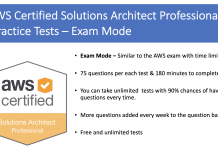This AWS practice test helps you to pass the following AWS exams and can also helps you to revise the AWS concepts if you are preparing for AWS interviews.
Advertisement
- AWS Certified Solutions Architect Associate
- AWS Certified Cloud Practitioner
Below AWS practice tests has two different Modes
- Learning Mode: 25 questions per test with answers and explanation, no time limit, repeat tests
- Exam Mode: 65 questions per test (similar to real AWS exam), 130 minutes, repeat tests
AWS Certified Solutions Architect Associate (SAA) – Learning Mode
10 votes, 4.5 avg
338Ready to take AWS Certified Solutions Architect Associate (SAA) – Exam mode ?
AWS Certified Solutions Architect Associate (SAA) – Exam Mode
5 votes, 4.8 avg
154Need more practice ? take the AWS Certified Solutions Architect Associate (SAA) – Learning mode
Sponsored Links



